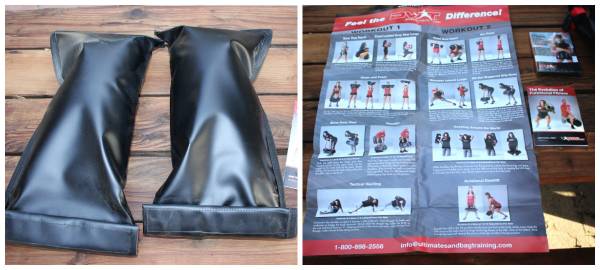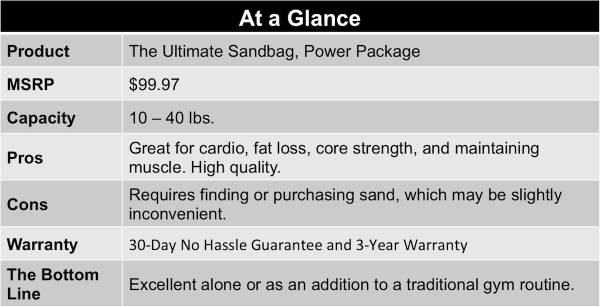People are always looking for simple and effective ways to get fit, especially at the start of the new year. We found the Ultimate Sandbag (USB) to be an excellent choice for those looking for an at-home solution to losing weight, building strength, and challenging those all-important core muscles.
Ultimate Sandbags are extremely sturdy, highly versatile, and can be adjusted to keep challenging you as you improve.
The Ultimate Sandbag Testing Conditions
I’m an experienced coach and former gym owner who has holds multiple certifications. The Ultimate Sandbag is specifically designed for use with Dynamic Variable Resistance Training (DVRT), so this is how the bag was tested. Following DVRT movements and workouts, I put the “Power” bag through its paces on carpet, grass, and concrete surfaces for a week.
The “Power” is one of the smaller bags in the USB product range. Described as “Best for “Rotational Training, Movement-Based Exercises, Intermediate Women, and Complex Movements,” the bag’s recommended load range is 10-40lbs. I tested the black one, but this bag is also available in camouflage and pink.
Setting up the Ultimate Sandbag
Upon arrival, the “Power” bag shell is basically a stiff, heavy-duty duffle bag. The outer material is smooth but very think, and the overall quality of construction is excellent. I was glad to find that the bag material is not at all abrasive, and it does not absorb sweat. There are a variety of handles, which allows for a wide range of exercises.
The filler bags that actually hold the sand are separate. These are thick black bags that have multiple sets of Velcro closures. The filler bags are a bit of a wrestling match just to open—there’s a lot of Velcro to deal with. But if you squish them around some, you can get the mouth to stay open and the bag to stand up, making it much easier to fill. I used sand that was leftover from filling “real” sandbags as part of last year’s El Niño prep. This sand is coarser than the recommended “playground sand,” but that did not seem to affect performance. Beginners are actually urged to use rice or other, lighter, filler. So there is definitely room for variation on the fill. The filler bags seal up very well, and seem pretty bullet-proof.

Left: The Ultimate Sandbag unfilled; Right: filler bags (before filled to capacity).
Getting the loaded filler bags into the shell was also a bit of a wrestling match, too, but they do fit. It helped to pick up and drop the bag (on a hard, safe surface) to get the filler bags “settled in.” The shell’s main compartment closes with a heavy-duty metal zipper and lots more Velcro.
I’m a pretty experienced lifter and know a thing or two about exercise, so I figured I could start by loading each of the two fillers supplied to capacity, 20lbs each, bringing the “Power” bag to its maximum (40lbs). At only 40lbs, I figured it would be good to start with the more challenging exercises.
Boy, was I in for a surprise.
Using the “Power” Ultimate Sandbag
I had not trained with sandbags before. But, ironically, I filled nearly a hundred of them before a threatened El Niño rainy season here in southern California last year. I have been curious to try formally training with them, and always imagined they’d basically be used like interesting, but lighter, versions of barbells and kettlebells.
But, because there is some instability due to the shifting sand inside the bag, sandbag training is quite different from barbell lifting and kettlebell work. The USB is slightly unstable—not wildly so, but noticeably so. It’s not like standing on a Bosu or unstable surface; you get to have your feet on the floor. But it is also not like a “slosh pipe” or other highly unstable tool. The degree of instability feels challenging, but manageable.
It is likely this instability that makes the 40lb “Power” bag feel like a whole lot more—maybe what 40lbs would feel like on Jupiter.
I began training by trying some of the more advanced and complex movements, but found myself struggling too hard to keep good form. So I decided to work on more basic movements, rather than reduce the weight and do the more advanced stuff right away. This turned out to be a good decision.
Although the training does involve some familiar movements, like deadlifts and cleans, these are substantially different with the DVRT and the “Power” USB. Compared with the barbell and kettlebell work I was used to, DVRT movements with the “Power” bag had me sore in more and in different places.
DVRT and the “Power” USB have done a good job of challenging my core, balance, and posture. My core muscles seemed especially challenged, even by movements that were not targeting them. DVRT includes rotational movements and dynamic sequences that are unlike my previous barbell and kettlebell training, and these movements with the “Power” bag feel very effective at building stability, resilience, and improving the ability to resist force as well as generate force.

Left: Filler bags filled to capacity; Right: Included training materials.
My Recommendation: Thumbs Way Up
I highly recommend the “Power” Ultimate Sandbag for anyone seeking something new, safe, and challenging that will burn calories, build strength, and increase core strength and stability.
Ultimate Sandbags are a great choice for at-home fitness. You can use them on just about any surface – carpet, wood, concrete, grass – and they require far less room than a barbell and rack set up. The bags are not destructive to floors and surfaces like weight plates and kettlebells can be. But, you will need some overhead room. (From experience, I can tell you it’s not good a good idea to use the USB in a room with a ceiling fan.)
The Ultimate Sandbag offers a complete line of sandbags, each with its own purpose and characteristics. The main lineup includes five sizes, from the “Core” bag recommended for 5-20lbs, all the way up to the “Burly” bag that can handle a hefty 150lbs. There is also a more affordable “Kick-Start” bag, with a load range from 10-40lbs, which is recommended for “home users, boot camps, and first-time users.”
The bottom line is that the combination of the DVRT system and “Power” sandbag is a smart and safe way to boost your fitness at home and on your own schedule. It will be effective and challenging for any level of fitness. Despite the testing period being over, I’m going to continue with DVRT and the “Power” bag as part of my training.

Get your cardio training going with a new pair of running shoes:






